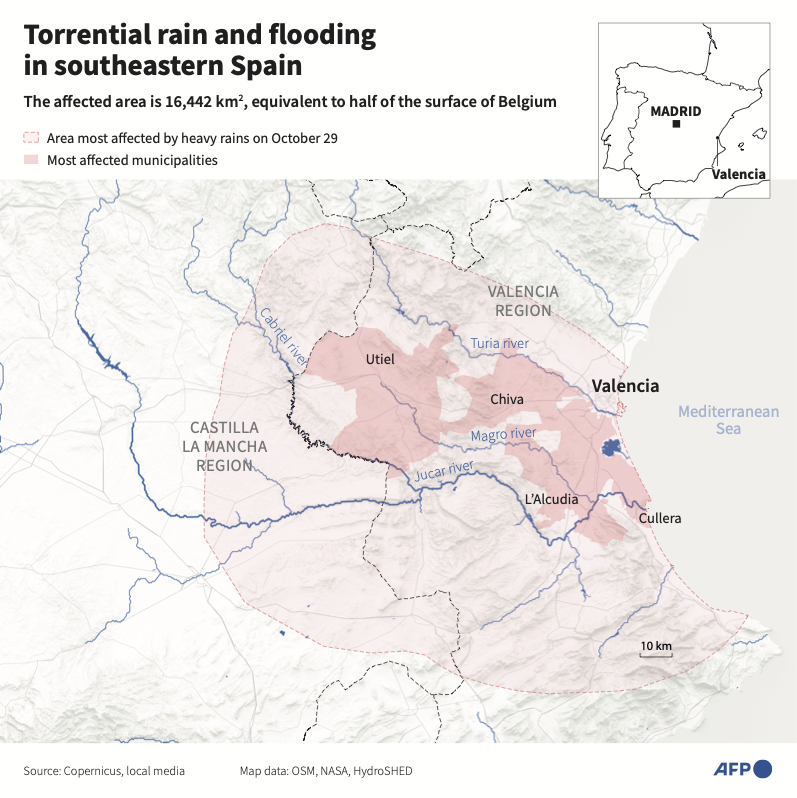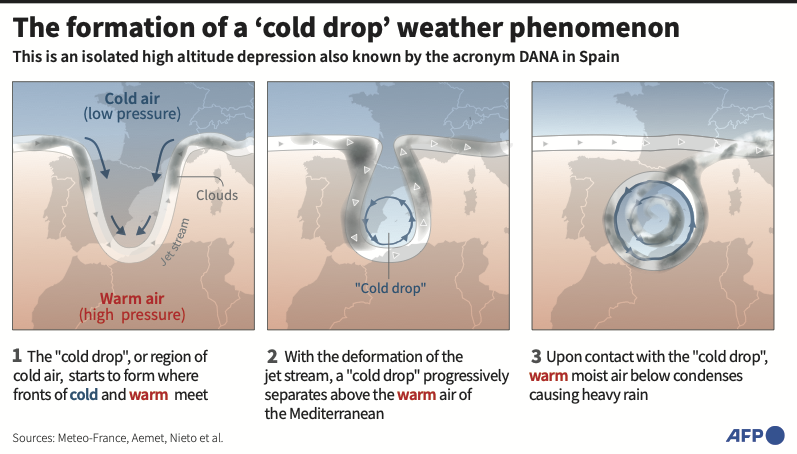Scientists said the immediate cause of the flooding is called a cut-off lower-pressure storm system that migrated from an unusually wavy and stalled jet stream
The extreme weather event came after Spain battled with prolonged droughts in 2022 and 2023. Experts say that drought and flood cycles are increasing with climate change
VALENCIA, Spain: In a matter of minutes, flash floods caused by heavy downpours in eastern Spain swept away almost everything in their path. With no time to react, people were trapped in vehicles, homes and businesses. Many died and thousands of livelihoods were shattered.
Five days later, authorities have recovered 217 bodies — with 213 of them in the eastern Valencia region. They continued to search on Sunday for an unknown number of missing people with the help of some 5,000 fresh soldiers who arrived over the weekend.
An enraged crowd in hard-hit Paiporta hurled mud and other objects at Spain’s royals, Prime Minister Pedro Sánchez and regional officials when the leaders made their first visit to the epicenter of the flood damage on Sunday.

Locals and volunteers remove muddy water on Nov. 1, 2024, after a flooding devastated the town of Paiporta, in the region of Valencia, eastern Spain. (AFP)
Thousands of volunteers were helping to clear away the thick layers of mud and debris that still covered houses, streets and roads, all while facing drinking water cuts and shortages of some basic goods. Inside some of the vehicles that the water washed away or trapped in underground garages, there were still bodies waiting to be identified.
Here are a few things to know about Spain’s deadliest storm in living memory:
What happened?
The storms concentrated over the Magro and Turia river basins and, in the Poyo riverbed, produced walls of water that overflowed riverbanks, catching people unaware as they went on with their daily lives on Tuesday evening and early Wednesday.
In the blink of an eye, the muddy water covered roads and railways, and entered houses and businesses in towns and villages on the southern outskirts of Valencia city. Drivers had to take shelter on car roofs, while residents took refuge on higher ground.

Spain’s national weather service said that in the hard-hit locality of Chiva, it rained more in eight hours than it had in the preceding 20 months, calling the deluge “extraordinary.” Other areas on the southern outskirts of Valencia city didn’t get rain before they were wiped out by the wall of water that overflowed the drainage canals.
When authorities sent alerts to mobile phones warning of the seriousness of the flooding and asking people to stay at home, many were already on the road, working or covered in water in low-lying areas or underground garages, which became death traps.
Why did these massive flash floods happen?
Scientists trying to explain what happened see two likely connections to human-caused climate change. One is that warmer air holds and then dumps more rain. The other is possible changes in the jet stream — the river of air above land that moves weather systems across the globe — that spawn extreme weather.
Climate scientists and meteorologists said the immediate cause of the flooding is called a cut-off lower-pressure storm system that migrated from an unusually wavy and stalled jet stream. That system simply parked over the region and poured rain. This happens often enough that in Spain they call them DANAs, the Spanish acronym for the system, meteorologists said.
And then there is the unusually high temperature of the Mediterranean Sea. It had its warmest surface temperature on record in mid-August, at 28.47 degrees Celsius (83.25 degrees Fahrenheit), said Carola Koenig of the Center for Flood Risk and Resilience at Brunel University of London.
The extreme weather event came after Spain battled with prolonged droughts in 2022 and 2023. Experts say that drought and flood cycles are increasing with climate change.

Has this happened before?
Spain’s Mediterranean coast is used to autumn storms that can cause flooding, but this episode was the most powerful flash flood event in recent memory.
Older people in Paiporta, at the epicenter of the tragedy, say Tuesday’s floods were three times as bad as those in 1957, which caused at least 81 deaths. That episode led to the diversion of the Turia watercourse, which meant that a large part of the town was spared of these floods.
Valencia suffered two other major DANAs in the 1980s, one in 1982 with around 30 deaths, and another one five years later that broke rainfall records.
The flash floods also surpassed the flood that swept away a campsite along the Gallego river in Biescas, in the northeast, killing 87 people, in August 1996.
What has the state response been?
Management of the crisis, classified as level two on a scale of three by the Valencian government, is in the hands of the regional authorities, who can ask the central government for help in mobilizing resources.
At the request of Valencia’s regional president, Carlos Mazón, Sánchez announced Saturday the deployment of 5,000 more soldiers who will join rescue efforts, clear debris and provide water and food. The new soldiers will join the 2,500 others involved in the emergency work.
The government has also pledged to send 5,000 more Civil Guard gendarmes and National Police officers to the region, nearly doubling the 4.500 already there.
When many of those affected said they felt abandoned by the authorities, a wave of volunteers arrived to help. Carrying brooms, shovels, water and basic foods, hundreds of people walked several kilometers to deliver supplies and help clean up the worst-affected areas.
Sánchez’s government is expected to approve a disaster declaration on Tuesday that will allow quick access to financial aid. Mazón has announced additional economic assistance.
The Valencia regional government was criticized for not sending out flood warnings to cellphones until 8 p.m. on Tuesday, when the flooding had already started in some places and well after the national weather agency issued a red alert indicating heavy rains.






















